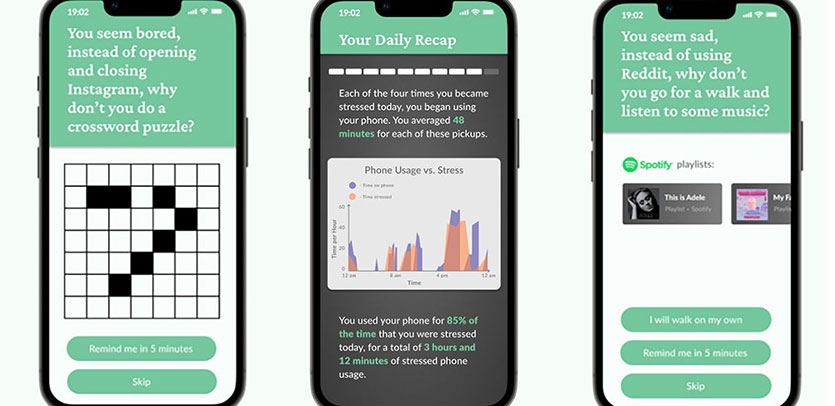An Intermission for Mental Health
Roni Greenberg’s Thesis project focused on an app designed to break the downward spiral of mental illness linked to and worsened by smartphone use.
Roni Greenberg saw two things when he looked around at a world filled with people whose heads were buried in their smartphones.
The first was a disturbing problem. The second was an opportunity.
As a student in Northwestern's Engineering Design Innovation (EDI) program, Greenberg (EDI '22) learned how smartphone use can be both a trigger for mental illness and an unhealthy coping mechanism that contributes to a sometimes dangerous downward spiral.
So Greenberg used the two quarters dedicated to his Thesis project – EDI’s capstone class designed to give students the opportunity to dive deeply into a topic they are passionate about – to develop the concept for an app that offers safety to those in the midst of that downward spiral.
Greenberg’s app idea is called Intermission. The foundation is built on the idea that while smartphones have become an essential part of how humans socialize, they open up a wide range of potential dangers that people don’t have the right tools to navigate. Many users are afraid to take positive steps to have a healthy relationship with their phone because they feel their social life will suffer as a result.
“Intermission addresses the underlying mental health factors that cause high phone usage and helps users establish healthy relationships with their phone,” Greenberg said. “It does so by interrupting destructive cycles and unveils detailed behind-the-scenes phone usage patterns of which most users are unaware.”
Greenberg’s belief in function over form was born when he was in college pursuing a bachelor’s degree in manufacturing and design engineering from Northwestern. A herniated disc in his lower back left him in constant pain and, after a year of intense physical therapy failed to provide relief, landed him in the operating room.
“My eyes were opened to the impact a well-designed product or service could have in relieving my pain,” said Greenberg, a self-identified lifelong creator who comes from a family with deep artistic roots. “To design a chair solely to be a beautiful chair might be enjoyable, but designing a chair that is beautiful and easy to get in and out of for users with lower back pain? That is far more fulfilling and nourishing.”
His own health journey impacted how he understood mental health, and in turn played a role in creating Intermission. Through his research, he saw that no apps designed to limit screen time do so through the lens of mental health, rendering them largely ineffective.
“They look at screen time as a binary measure with daily thresholds,” he said. "(That) fails to account for the variety of situational factors that impact the way people use their phone on a daily basis.”
Intermission takes a different approach. Rather than simply say, “You’ve been on your phone for the allotted time today,” Greenberg’s concept takes into account behavioral factors. For example:
- What underlying emotional needs drive specific phone behaviors?
- How is time spent on a user’s phone correlated with stress, as tracked by a linked wearable device?
- Is there higher usage of certain apps or features after receiving a specific kind of alert, such as one about tragic national news?
- Does a chain of actions occur frequently, such as a text message that leads to a response that leads to an hour of doom scrolling on a social media channel?
Greenberg sought real-life examples of how smartphone use hurts mental health, and his research for Intermission included visits to support groups for people addressing technology addictions. In the process, he improved his ability to conduct difficult interviews while developing meaningful product design.
For now, Intermission remains a concept and not an actual app under development. Time is the challenge, as the recent-graduate works as a telehealth experience strategist for health care provider Kaiser Permanente. There, he works with clinicians, patients, user experience designers, and product teams to help develop new and existing tools to help people manage their health.
Greenberg said his EDI experience – especially with the Thesis project – is playing a huge role in helping him be more effective on the job.
“I am so much more aware of how to create professional quality work,” Greenberg said. “Students are given the freedom to explore a project of their own choosing, an opportunity that is very rare for designers once we start working.”


